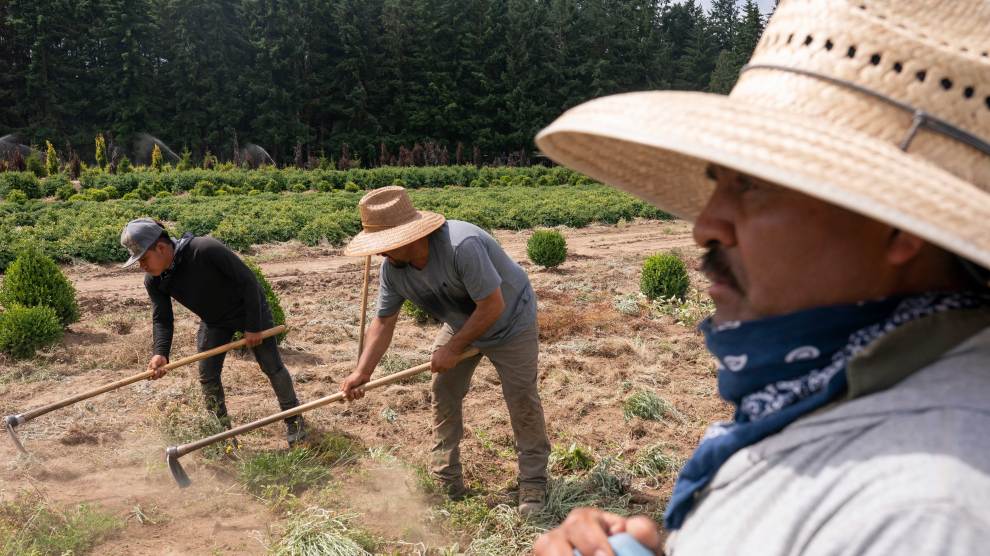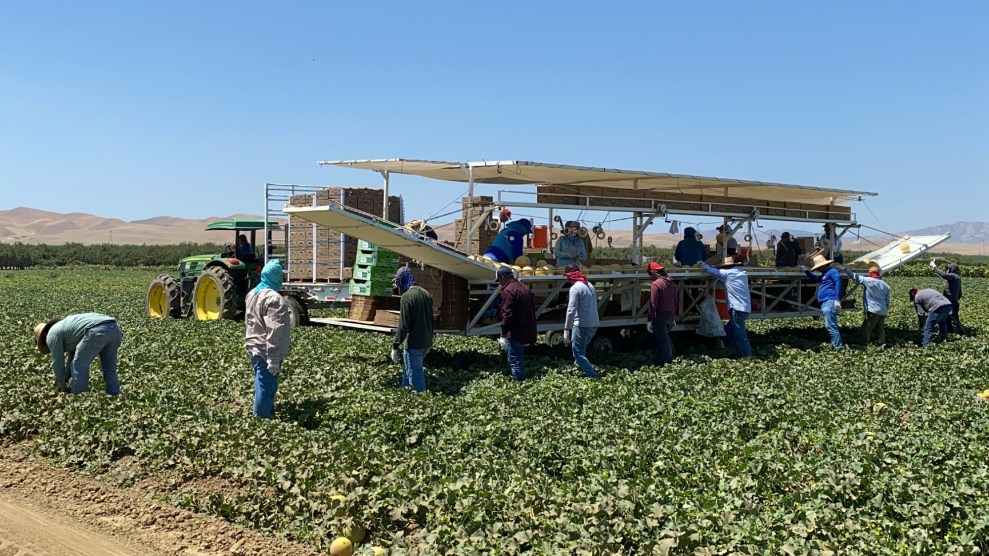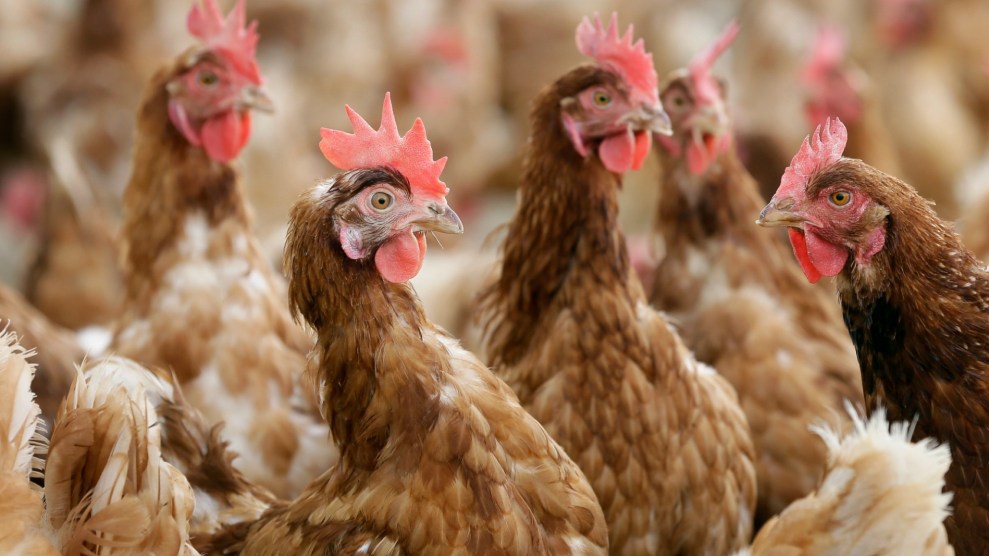
Farmworkers, who declined to give their names, break up earth on July 1, 2021, near St. Paul, Ore., as a heat wave bakes the Pacific Northwest in record-high temperatures.Nathan Howard/AP
This story was originally published by the Food and Environment Reporting Network (FERN).
Last June, as a record-breaking heatwave baked Oregon’s Willamette Valley, Sebastian Francisco Perez was moving irrigation lines at a large plant nursery in 104-degree-heat. When he didn’t appear at the end of his shift, his co-workers went looking for him, and found him collapsed between rows of trees. Investigators from the Oregon Occupational Safety and Health Division determined that Perez died of heat-related hyperthermia and dehydration.
They also found that Perez had not been provided with basic information about how to protect himself from the heat. It wasn’t the farm’s first brush with regulators; it had previously been cited for failing to provide water and toilets to its workers. Later, in a closed conference with the Oregon health and safety agency, an Ernst Nursery & Farms official blamed Perez for his own death, claiming that employees should “be accountable for how they push their bodies.”
This year, in a move to avert similar deaths—and force employers to take responsibility for protecting workers during hot weather—Oregon adopted the most stringent heat protections for outdoor workers in the country. The rule kicks in when temperatures reach 80 degrees and requires employers to provide cool water, rest breaks and shade, as well as to make plans for how to acclimatize workers to heat, prevent heat illness and seek help in case of an emergency.
The new standard has been praised by advocates, but industry is already pushing back. On June 15, the day the rule took effect, a coalition of Oregon business groups representing more than 1,000 companies filed a lawsuit seeking an injunction against the heat standard and another new rule governing workers’ exposure to wildfire smoke, arguing that they are unconstitutional. But the rules stand for now, making Oregon the third state to enact such standards for outdoor workers, after California and Washington.
In the rest of the country, as climate change drives increasingly brutal heat waves, farmworkers lack protection. How they fare will largely depend on whether their employers voluntarily decide to provide the access to water, shade, and rest breaks that are critical when working in extreme heat. There are currently no nationwide regulations that spell out what employers must do to protect workers from heat and, while efforts to draft a federal rule recently began, it will likely be years before the standards are in place.
Farmworkers are up to 35 times more likely to die from heat-related illness than workers in general, according to an analysis of Bureau of Labor Statistics data. And the risk will only grow as the climate crisis intensifies, and particularly if swift action to cut emissions is not taken. Already, 21 days per season in US crop-growing counties are considered unsafe because of the heat, according to a 2020 study. By 2050, if global average temperatures rise by 3.6 degrees Fahrenheit (2 degrees Celsius), that number is projected to reach 39 days per season. By 2100, if the current emissions trajectory continues, average temperatures are projected to rise more than 7.2 degrees Fahrenheit (4 degrees Celsius), which would make 62 days per year unsafe for workers in crop-growing regions, and render the southernmost parts of the US unsafe for the entire growing season.
Agricultural workers are doubly vulnerable to the hazards of heat. The nature of their jobs means they spend long hours outside in hot weather. But a number of other factors exacerbate this risk. Labor laws in the US prevent most farmworkers from unionizing, so they lack leverage in negotiations with employers. Most farmworkers are either undocumented or in the country on H-2A temporary work visas, which are tied to a single employer—if workers complain or otherwise cause problems for employers, they risk deportation. Many farmworkers don’t speak English and lack access to affordable healthcare. Workers often aren’t paid an hourly wage but on a piece-rate basis; getting paid by the bucket, bundle or pound can disincentivize workers from taking a break, advocates say. And crew leaders, who are employed by farms to oversee workers, often get paid bonuses based on how much their crews harvest.
“When it comes to agricultural workers, the lack of climate change policies, worker protection policies, immigration policies, and public health policies all collide, and that makes them quite a vulnerable population,” said Roxana Chicas, a nurse and professor at Emory University’s Nell Hodgson Woodruff School of Nursing, who researches the effects of climate change and heat on farmworkers.
“The conditions are uniquely bad in agriculture,” said Juley Fulcher, the worker health and safety advocate at Public Citizen, an advocacy organization that has been petitioning the Occupational Health and Safety Administration (OSHA) for a heat standard for more than a decade. “These folks have zero power to complain.”
According to a review of records from the federal OSHA, at least 22 agricultural workers have died from heat-related illness over the last five years. Among them were three people working in tomato fields in Florida and Georgia; an Indiana worker who was detasseling corn; a California sheep herder; and workers harvesting tobacco in North Carolina and Connecticut.
But these records are incomplete. They don’t include, for example, a Washington farmworker who died while harvesting hops last July or the death of a second corn detasseler in Indiana who advocates say died in 2020. And federal statistics often undercount fatalities and injuries, Fulcher said. Some of the federal counts rely on employer-reported information, and certain deaths are never reported while others are attributed to conditions that may have been caused or exacerbated by heat stress, she noted.
Tipu Khan, a doctor in Ventura County, California, who provides care to farmworkers, has seen firsthand the toll that heat takes on their bodies. Heat illness starts with nausea, fatigue and vomiting, he said, and can progress to seizures as the body loses its ability to regulate its temperature. As a person’s temperature rises, blood flow to their brain drops, raising the risk of a stroke or brain damage.
Morgan Raines, an emergency room nurse who has treated farmworkers in Florida and Oregon, said workers exposed to extreme heat come to the emergency room in an altered mental state, often incoherent and confused, with high body temperatures and elevated heart rates. “It’s all hands on deck—a massive medical emergency,” she said.
In the ER, doctors and nurses scramble to bring patients’ temperatures down before their organs start to fail. They cover them with ice packs and run cool saline solution through their veins. “You’re essentially trying to cool them off before they cook themselves to death,” Raines said.
Mounting research also suggests that chronic exposure to high heat—even when it doesn’t result in an urgent medical emergency—can cause lasting damage to the body. Chicas, the Emory University professor, helped conduct a 2021 study that measured Florida farmworkers’ creatinine levels—an indicator of how well the kidneys are functioning—during hot weather. On one 10-hour workday when the heat index averaged 89 degrees Fahrenheit, workers’ creatinine levels rose to a level consistent with kidney injury. At the same time, four out of five of the workers in the study had body temperatures that exceeded OSHA’s recommended limit of 100.4 degrees F.
The researchers also discovered that most of the workers were already dehydrated before beginning their shifts, indicating they were struggling to rehydrate enough in the evening after work. Both Chicas and Raines said constant dehydration stresses the kidneys, and may explain anecdotal evidence that U.S migrant farmworkers are developing chronic kidney disease (CKD) at much younger ages than most Americans. CKD is typically a disease of the elderly, but Raines says she saw farmworkers in their 30s and 40s in the ER, needing dialysis, adding: “But a lot of farmworkers are undocumented, so how are they going to get that care?”
Pregnant people are more prone to heat exhaustion and heat stroke, and heat increases the risk of stillbirth and preterm delivery. This is especially concerning as more and more farmworkers are women, said Amy Liebman, director of environmental and occupational health at the Migrant Clinicians Network. She said it’s a delicate balance between making sure pregnant workers get the protections they need without interfering with their ability to earn a living.
For years, unions, advocates and even governmental agencies like the Centers for Disease Control and Prevention have tried to get the US Department of Labor to pass an enforceable standard that would protect workers from heat hazards. Finally, last October, the Biden administration, as part of its response to climate change, signaled that it is inching toward a regulation; OSHA announced that it has begun the process of drafting a rule to protect workers from extreme heat exposure. But it could be as long as seven to 12 years before the regulation is finalized—and even once passed, rules can be tied up in legal challenges. And it will surely face opposition from powerful industry groups in agriculture, oil and gas and the building trades.
Already, in public comments filed in response to OSHA’s advance notice of rulemaking, numerous industry groups questioned the premise of the rule. The National Council of Agricultural Employers, for example, wrote that “there is no need for additional regulation” because employers are already protecting workers’ health. The Georgia Fruit and Vegetable Growers’ Association expressed “deep concerns” that any moves to mandate “excessive rest” or cut work hours during the harvest season would “have drastic negative impacts on our growers who are already going to great lengths to provide safe conditions for their workers.” (Since 2017, at least three farmworkers have died in Georgia from heat-related causes. Only Florida and California reported more deaths, with four each.)
While a heat standard winds its way through the regulatory process, OSHA is making enforcement of heat hazards more of a priority. Under a new “national emphasis” program, for example, OSHA inspectors will inspect job sites if workers complain about heat hazards or when employers report that a worker was hospitalized for heat-related injury. And if OSHA inspectors are investigating a site for non-heat-related reasons and see a potential heat hazard, they will either open a heat investigation or make a referral.
“Something’s better than nothing,” said Fulcher, of Public Citizen, though she noted that much of this new focus consists of things the agency is already supposed to be doing, like following up on complaints. While the program is mostly educational, she said it does clarify what employers should be doing to protect workers. But OSHA is underfunded and understaffed, which could undercut its efforts even to put this modest proposal into practice, Fulcher said.
To protect workers right away, Public Citizen on Tuesday issued a report calling on OSHA to create an emergency temporary heat standard that would spell out the steps employers are required to follow—such as ensuring water access and rest breaks, and reporting heat-related illnesses and injuries—until permanent rules take effect.
In the absence of federal regulations, a small handful of states has attempted to pass their own heat standards. California was the first. In the summer of 2005, after at least four farmworkers died in a matter of weeks, the state issued emergency heat regulations that were later made permanent. Under the rule, which was strengthened in 2015, California farmers are required to provide workers with cool drinking water, shade and rest breaks when temperatures hit 95 degrees, and to give workers the option to rest at temperatures of 80 degrees and above.
Since then, Oregon and Washington have instituted heat standards for workers and Minnesota has adopted a heat rule, but only for indoor workers. Nevada, Maryland, and Colorado have passed laws requiring state agencies to develop heat standards for workers. But attempts to strengthen heat protections have failed in other states, including North Carolina, Maine, and Virginia, according to the National Conference of State Legislatures.
Even if more states manage to pass laws protecting workers from heat, a patchwork of state laws is no substitute for robust federal legislation, advocates say. Only 22 states are authorized to operate their own occupational health and safety agencies. These state agencies have the leeway to institute rules that are much stricter than federal OSHA’s, as in the case of Oregon and California. But more than half of US states have no state OSHA, which means they must follow federal rules; they couldn’t institute stricter standards even if they wanted to.
Recent research suggests California’s regulations are helping: heat is causing fewer workplace injuries since the state adopted its standard. But farmworkers are still being injured and dying from heat-related illness. Roxana Chicas points out that the same kidney injuries found in Florida workers have been identified in California workers, indicating that the state’s heat standard still might not be enough in the face of climate change. The state is getting hotter as climate change accelerates, and labor organizers argue the heat standard is often unenforced.
David Hornung, the Heat and Agriculture Program Coordinator at California’s Occupational Health and Safety Administration (Cal/OSHA), acknowledges that enforcement is a problem. “We don’t have all the resources we want to address this issue,” he says. The agency is chronically understaffed. Cal/OSHA is aggressively hiring, Hornung says, but as it stands now, it has about 200 inspectors—and there are between 19 million and 20 million workers in California.
Investigating a labor violation on a sprawling agricultural operation is tricky, even with a sufficient number of inspectors. According to Armando Elenes, the United Farm Workers’ secretary treasurer, there can be up to a hundred different field crews working at any given time, many of them employed by different labor contractors. “You’re looking for a needle in a haystack,” he says.
To make a law like the heat standard stick, says Elenes, you need to get pretty proactive. UFW members used to conduct “sweeps” past the agricultural fields in California’s Central Valley, hunting for operations that weren’t following the heat rules. “I used to measure how effective we were by the number of minutes it would take me to find a violation,” Elenes says. Back in 2006, he says, he could find a farmer in violation in 10 minutes. Now, he’s up to 25 minutes. He says the state’s making progress.
Meanwhile in Oregon, Ira Cuello-Martinez, policy manager at the farmworkers’ union Pineros y Campesinos Unidos del Noroeste (PCUN), is cautiously optimistic about the state’s new standard, which is similar to California’s but more comprehensive and specific. “We’re excited to be able to share this information with workers,” he says.
But in Virginia, where an attempt to enact a new heat standard failed in December, advocates are watching the weather report with dread. Two weeks ago, Christianne Queiroz, who directs the Virginia Farm Workers Program at the Central Virginia Legal Aid Society, visited migrant camps. Most of the workers she met there complained of having constant muscle cramps, which is a common reaction to heat exposure.
Looking ahead to a week in which the heat index was predicted to hit 96 degrees, she said she felt powerless. “It’s terrible, she said. “I’m really at a loss right now. What can I do other than just watch this disaster of a season coming?”
For now, in the absence of regulations in most states, advocates do what they can to minimize harm. Queiroz’s group tries to warn workers about heat via WhatsApp messages. In the Midwest, advocates lead heat stress trainings for migrant workers who come to detassel corn. Among the lessons: pair up when entering the fields, and wear orange so you are easier to spot if you collapse in the vast cornfields, which can span hundreds of acres.
The hope is that these sessions will help workers avoid the fate of other corn detasselers who have died in recent years; it took 50 days to find the body of one worker who collapsed in an Illinois corn field in 2011.
“We stress that they go into the fields with a partner and stay together,” said Esperanza Gonzalez, the operations and minority health director at the Illinois Migrant Council. “Because if they get disoriented and they’re alone, they might not come out.”













